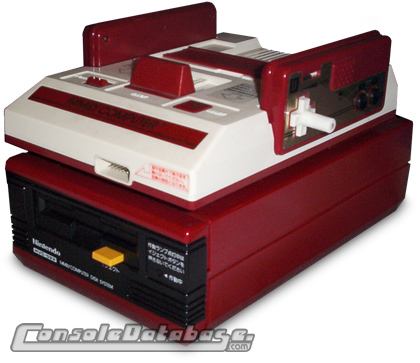![]()
http://www.consoledatabase.com


The Famicom Disk System (FDS) was released in 1985 throughout Japan (where the Famicom had been overwhelmingly popular since its 1983 release) and some other parts of Asia. At this time, most of the current Famicom ROM cartridge games were very basic - simple arcade ports and one-screen games - due to the small capacity of cartridges of that time.
Nintendo's answer to this was to release an add-on for the Famicom that would allow disk-based games to be played on the system. Disks were cheaper to produce, had 64K capacity per side (a total of 128K), can have their content changed (i.e. saved over) by the buyer and games can include a save feature.
The Famicom Disk System sat underneath the Famicom and connected to the Famicom via a RAM adapter. It ran on 6 C-sized batteries, however, an AC-adaptor could be purchased separately, but these are very hard to come by today. The disks (called "Disk Cards") were proprietary 3 inch x 4 inch floppies that were a slight modification of Mitsumi's "Quick Disk" format, used in some Japanese computers and MIDI keyboards.
Japanese game enthusiasts liked the idea of the disks as you could buy a disk for around 2000 Yen, compared to 5000 - 7000 Yen for a cartridge. Then, when you wanted to try a new game, you could get a new game saved to the disk for around 500 Yen. Disk Writers were available in toy and department stores throughout Japan, allowing people to save a new game to their existing disk, or onto a blank disk bought from the store for very little money.
This, of course, had its problems, due to the fact that profit margins for both game companies and the toy stores were very small. Nintendo also demanded part of the copyright of all Disk System games (in order to sell them through Disk Writers), thus many game companies ignored the system.
Four months after the FDS's release, the first 128K cartridge, Ghosts 'n Goblins, was released for the Famicom. This, along with the introduction of battery back-up cartridges (such as The Legend Of Zelda) made the Famicom Disk System not look so good anymore.
A major problem with storing games on disk was piracy. Pirates, especially in Hong Kong and Taiwan, worked out ways to illegally port cartridge games cheaply and easily onto blank disks. They would then sell these at a profit. A number of labels also came out producing adult titles for the Disk System. These labels included Super Pig, Saison and Phoenix (all various labels of Hacker International) and gave the Famicom Disk System a bad reputation. Pirates also managed to copy exclusive Famicom Disk System games onto cartridges - these were titles that were never officially released onto cartridge, such as Yume Koujou Doki Doki Panic.
It is most likely due to the piracy and lack of support for the system that the FDS did not perform as well as Nintendo had hoped, even though it sold over 2 million units in 1986. Nintendo kept Disk Writers in stores up until 1993 and up until September 2003, you could still send a blank disk and 500 Yen in stamps to Nintendo of Japan and they would send the disk back to you with a game of your choice. Today, the FDS is hard to come by outside of Japan, but is worth looking for if you're into collecting for the Nintendo Famicom.
Platform: Nintendo Famicom Disk System.
Copyright © 2000 - 2024 Base Media. All Rights Reserved. Console Database is a trademark of Base Media. Designated trademarks and brands are the property of their respective owners. Use of this Web site constitutes acceptance of the Base Media User Agreement and Privacy Policy. Our other sites: Deals United - Daily Deals Aggregator and WhichPlug? - Travel Adaptor Finder.